|
|
|
|
|
|
|
|
|
|
|
|
|
|
|
|
|
|
|
|
|
|
|
|
|
|
|
|
|
|
|
|
|
|
|
|
|
|
|
|
|
|
|
|
|
|
|
|
|
|
|
|
|
|
|
|
|
|
|
|
|
|
|
|
|
|
|
|
|
|
|
|
|
|
|
|
|
|
|
|
|
|
|
|
|
|
|
|
|
|
|
Revised 4/05/04
|
|
|
|
|
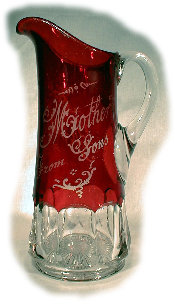
|
|
|
WELCOME to Ralph Berglund's website for souvenir Early American Pattern Glass. To skip the following narrative material and go directly to the sample Patterns, Click here.
|
|
|
|
|
|
To return to Bergie's Home Page Click here
|
|
|
|
|
|
|
|
|
|
|
|
|
|
|
|
|
|
|
|
|
|
|
|
|
|
|
|
|
|
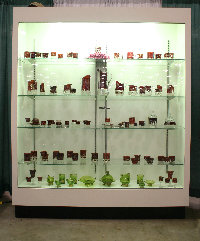
|
|
|
|
|
Although these items were sold as souvenirs for events and places all over the country, I have concentrated on souvenirs of Atlantic City, New Jersey where I grew up. As a result of the emphasis on Atlantic City, part of my collection was featured at the March 2004 Atlantique City Antiques & Collectibles Fair, as a part of their celebration of Atlantic City’s susqui-centennial.
|
|
|
|
|
|
|
|
|
|
|
|
|
|
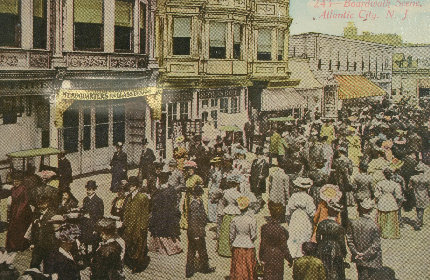
|
|
|
|
|
|
|
|
|
|
|
|
This postcard shows a typical early 1900’s boardwalk scene. Highlighted on one store’s awning is the phrase, “Headquarters For Glass Engraving”. Here you could purchase a piece of ruby-stained glass and have it engraved with “Atlantic City,” the date, and the name of a special person, e.g. Mother, Sister, Charles, Fay…...
|
|
|
|
|
|
|
|
|
|
|
|
|
|
|
|
|
|
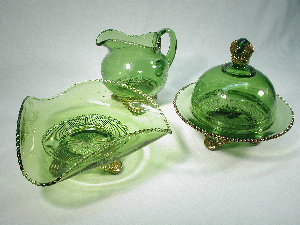
|
|
|
|
|
The pieces in the collection, though souvenirs of Atlantic City, are typical for souvenir pattern glass regardless of the event or place for which they were inscribed. Most souvenir pieces were ruby stained but the green Colorado State pattern pieces (see right) are also frequently seen as souvenirs. Click Here for more information on the names for this kind of pattern.)
|
|
|
|
|
|
|
|
|
|
|
|
|
|
|
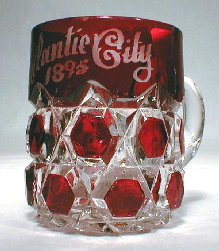
|
|
|
|
|
|
|
|
|
|
|
|
|
|
I acquired my first piece, a red block pattern mug, from my Mother who strolled the boardwalk in the early 1900's when these souvenirs were popular. In over twenty years of looking, I've not seen another red block piece as a souvenir. Since the stain had to be applied to each block individually, perhaps there was too much labor content for the souvenir market.
|
|
|
|
|
|
|
|
|
|
|
|
|
|
|
|
|
Most pieces that I've seen are dated in the 1890's and into the 1900's. In the early 1980's I started seeing other patterns at flea markets and antique or collectible shows, and began actively collecting. Pieces are found as pitchers, tumblers, creamers, mugs, cups, sugars, shots, stems, toothpicks and sometimes paperweights. The pitcher pictured at the top of the page is, at 11-3/8", the largest I've seen, and the largest Blocked Thumbprint Band pattern I've seen.
|
|
|
|
|
|
|
|
|
|
|
|
|
|
|
|
|
|
|
|
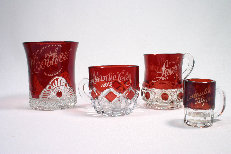
|
|
|
|
|
|
|
|
|
Some more pitchers, in Button Arches pattern (the most common for souvenir items) are shown here, ranging in size from 9" to 4".
|
|
|
|
|
|
|
|
|
|
|
|
|
|
|
|
|
|
|
|
|
|
|
|
|
|
|
|
|
|
|
|
|
|
|
|
|
|
|
|
|
|
|
|
|
|
|
|
|
|
|
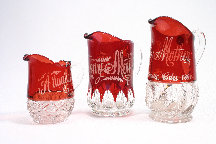
|
|
|
|
|
|
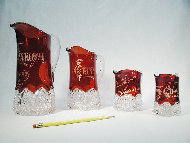
|
|
|
|
|
|
|
|
|
|
|
|
|
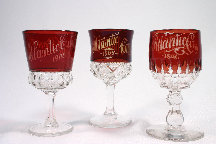
|
|
|
|
|
|
|
|
|
|
|
|
|
|
|
|
|
|
|
|
|
|
|
|
|
|
|
|
|
|
Still more pitchers in three other patterns.
|
|
|
|
|
|
|
|
|
|
|
|
|
|
|
|
|
|
|
|
|
|
|
|
|
|
|
|
Here we see a set of wines.
|
|
|
|
|
|
|
|
|
|
|
|
|
Then, there are the unusual pieces such as the slipper, the loving cup, and paperweights.
|
|
|
|
|
|
|
|
|
|
|
|
|
|
|
|
The glass patterns are attractive but the engraving artistry can also be impressive as seen below. I've also the same artistic styles in different pieces, leading me to think they were done by the same persons. The two on the right are like that as well as the tumbler on the right below.
|
|
|
|
|
|
|
|
|
|
|
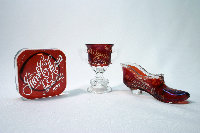
|
|
|
|
|
|
|
|
|
|
|
|
|
|
|
|
|
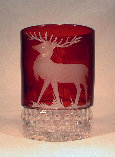
|
|
|
|
|
|
|
|
|
|
|
|
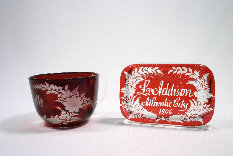
|
|
|
|
|
|
|
|
|
|
|
|
|
|
|
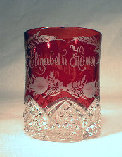
|
|
|
|
|
|
|
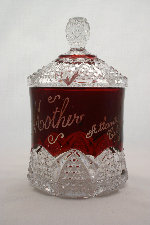
|
|
|
|
|
|
|
|
|
|
|
With the Internet, the ability to learn more about pattern glass has grown tremendously. I have found some excellent informative sites such as Early American Pattern Glass Society; EAPG Inc; and EAPGlass. With ebay the collecting possibilities have become greatly expanded. It was on ebay that I discovered the Colorado State pattern and its namesakes or AKA's (Also Known As).
I also heartily recommend the Eastern National Antique Show held twice a year in Harrisburg, Pennsylvania. It has been described as the premier glass show, and I don’t think that’s an exaggeration. It’s a beautiful scene. If you like glass this is THE place to go. I found this unique and attractive sugar bowl there.
|
|
|
|
|
|
|
|
|
|
|
|
|
|
|
|
|
|
|
|
|
|
|
|
|
|
|
|
|
|
|
|
|
|
|
|
|
|
|
|
|
|
|
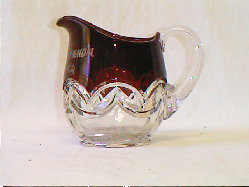
|
|
|
|
|
|
|
|
My collection currently (3/04) consists of about 100 pieces, most of them unique as to function and/or pattern, e.g. no more than one pitcher in a particular size and particular pattern. With my further requirements that pieces be from Atlantic City, and that they be acid-etched or wheel-engraved rather than pad-stamped or painted, it's getting harder to find new and interesting pieces. But I keep getting surprised and that's part of what makes it fun. Here are three unique pieces that I missed out on in eBay auctions, pieces that, interestingly, sold at upwards of $300 plus. Over the years I have paid prices ranging from $10 to $150 depending on the piece’s function, pattern, and size.
|
|
|
|
|
|
|
|
|
|
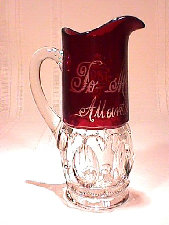
|
|
|
|
|
|
|
|
|
|
|
|
|
|
|
|
|
|
|
|
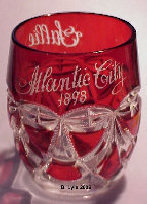
|
|
|
|
|
|
|
|
|
|
|
|
|
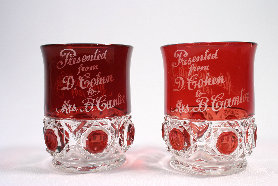
|
|
|
|
|
|
|
|
|
|
|
|
|
|
|
|
A rare find is a set as seen in these Box-in-box tumblers which Mr. Cohen purchased for Mrs. Cantor in 1899 (one speculates as to what inspired Mr. Cohen). Rarer still was the price I paid, a total of $18.
|
|
|
|
|
|
|
|
|
|
|
|
Click here for THUMBNAILS of the thirty-six patterns I have in the collection. Click on any thumbnail picture to see that pattern enlarged. In almost all cases pattern names are from Heacock's Encyclopedia of Victorian Colored Pattern Glass, Book 7, Ruby-stained Glass From A to Z (out of print but may be available through your library's inter-library loan system). I have just discovered (4/04) that a copy can be downloaded from The Ruby Stain Museum. This is a remarkable and worthwhile site for ruby-stained EAPG in general. Other patterns that I have identified from other sources include: Sunburst in Oval and Royal King, both of which were found in Edwards and Carwile's Pressed Glass 1860-1930; Block Band Diamond from Mollie Helen McCain’s 1982 Collector’s Encyclopedia of Pattern Glass; and Plain Miotin from Alice Metz’s 2000 Early American Pattern Glass. Note that Corona 1, 2, 3, and 4 are only my own perceived variations in the Corona pattern.
|
|
|
|
|
|
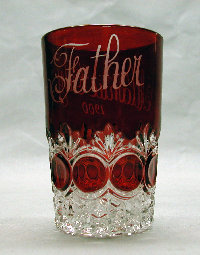
|
|
|
|
|
|
|
|
Note also that many patterns have AKA names but these are not listed on my site. I have used the generally or nominally favored names. Patterns that I have not been able to identify (such as the piece on the left) are marked with an @ followed by a personal reference name. If you can identify any of these patterns or if you have a question about an AKA, Click Here to e-mail me.
|
|
|
|
|
|
|
To return to Bergie's Home Page Click here
|
|
|
|
|
|
|
|
|
|
|
|
|
|
|
|
There were well over 1000 hits on this site in its 2002 version. You are visitor #  since the March 2004 renovation. Thanks for visiting. since the March 2004 renovation. Thanks for visiting.
|


















